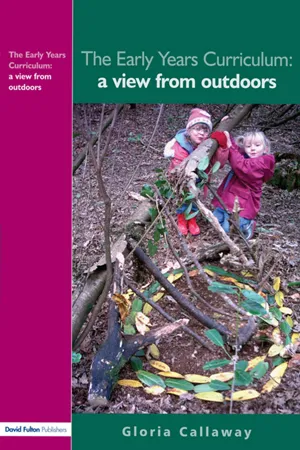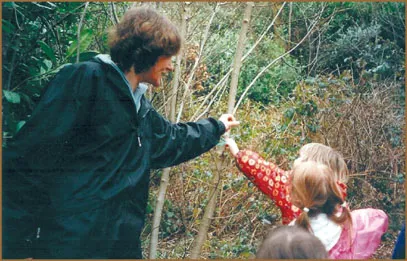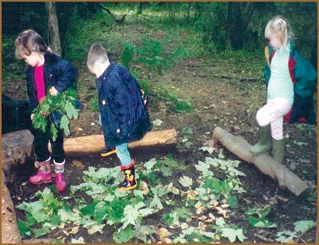![]()
Section Two
Principles into practice
Through accounts of typical sessions, this section examines how children learn while they walk through the woods; make base camp; name the trees; play hide and seek; enjoy snack time; make environmental art; make sounds in the woodland; and toast marshmallows on a fire. It also considers follow-up activities back at school.
The blue string trail
The minibus parked on the main path and its occupants disembarked to meet the leader. This is the starting point for their weekly walk through the couple of hundred yards to base camp, but this is much more than an access route. Blue string, tied at regular intervals on branches, indicates the way. Children learn that, each time they reach a marker, they should look for the next.
Then, they can proceed with confidence, concentrating on what they see and hear, touch and smell.
On this occasion, the leader spotted some spectacular fungi on the path, just beyond where the bus stops. She showed the children, and teased back the leaves around the two large yellow forms, because everyone knows you do not touch.
Children love the words ‘fungus’ and ‘fungi’. They know what they look like, and can use the words accurately, but had not realised that each fungus has its own name.
The leader had consulted her reference book earlier, and got it out to show the children. Pages were turned until they reached pictures of similarly coloured fungi. They scrutinised them, and found one that looked like theirs. They all agreed that ‘buttercap’ was a very good name.
This incidental use of a reference text demonstrates how to satisfy your curiosity, if you happen to have the right book. Non-fiction texts are often underused with young children, but even ‘grown-up’ books can be accessible with a little help. They had learned a lovely new word, but, even more importantly, they had been motivated to learn how to find what they wanted from the book.
At the start of the blue string trail, there was a short recap on the risks to look out for on the way. Children led the discussion, effectively carrying out a risk assessment for themselves.
What do we think about when we walk through the woods?
Roots. You've got to step over them.
Can we see one?
Yes — there — and therel
The roots were examined; the leader wondered where they came from. The children took the cue, following the root across the path, to see which tree it belonged to. Later, they might trace more roots, and perhaps find out which sort of tree has the biggest ones. They might look at photographs of frees and roots back at school. Next week, they might think about how some roots are very near the surface, while others go deep underground.
A distraction arrived, in the shape of a familiar small brown bird with a distinctive red breast, which often appears just here, as does another at base camp.
Why do we think the robin follows us on the path?
A pause; everyone had always taken it for granted.
What's on the ground just here?
Leaves. And mud — we get mud all over our boots!
And, when we walk along, what happens to the leaves?
They get all kicked up.
I wonder what lives under the leaves?
Insects. Is the robin after the insects to eat?
Gently prompted to make connections and deductions, they have come to a further understanding of the relationship between the robin and themselves, and perhaps learned that there might just be an ulterior motive to the bird's apparent friendship.
Back at school, there are books and other resources to glean more information about this bird, its territorial and nesting habits, and its camouflage.
Reference books are useful for children and adults, because few of us know as much as we might about even the most familiar creatures and plants. Without knowing how, where and when a robin builds a nest, how many eggs are in a clutch, how long they live, and what other birds share the territory, we cannot ask the right questions to encourage the children to make deductions. Saying, ‘how interesting!’ is not enough, so subject knowledge is vital, even if we are not experts.
A little further on, a child stopped to examine strange round-ish objects on the path. They have been seen before, but this week the leader probed a little further on the subject of oak galls.
I wonder what it is?
It looks like a slug. It's all slugged up.
It's like a ball shape.
The leader explained about the insect inside. They all looked.
Can you see it? Look! I can.
I think they're sleeping.
In the last stretch before base camp, children went to look at the ferns, which had delighted them by gradually uncurling week by week. There were some brown ones alongside fresh green ones, which promoted a short discussion about whether they were alive or dead. The children noticed other differences too, which could lead to a focus on closer identification of fern varieties on a future occasion.
In less than twenty minutes since they arrived, this group of children had:
- learned that fungi have distinct varieties and names, which can be looked up in a book;
- traced the inconvenient root back to its tree;
- found out about the insect ‘all slugged up’ inside the oak gall, so named because only oak trees have them;
- realised that robins like to eat insects from under leaves without having to dig, if they can, and
- worked out that ferns wither and die, but not necessarily all at the same time.
Base camp
Base camp is at the heart of the whole experience, not a sophisticated ‘den’, but a series of logs enclosing part of a small clearing, bounded by tall deciduous trees and bushes. Each group arranges the logs on their first visit, with technical tips from the adults. From then on, it is their ...





